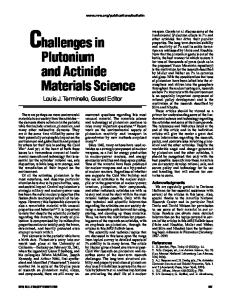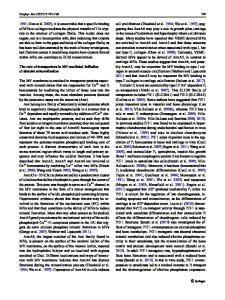Biomineralization and biotransformations of actinide materials
- PDF / 975,836 Bytes
- 11 Pages / 585 x 783 pts Page_size
- 99 Downloads / 387 Views
Introduction Bacteria are ubiquitous in every habitat on Earth and play important roles in transforming metals, corroding surfaces, cycling major elements and trace nutrients, forming or dissolving minerals, and sequestering or liberating environmental contaminants. The materials that result from environmental microorganisms transforming metals from their initial form to different solution species and solids have been characterized since the late 1980s. New forms of prevalent (e.g., iron, manganese, nickel), trace (selenium, arsenic, molybdenum), and contaminant (cadmium, mercury, arsenic) metals produced by these processes have been identified. The influence of bacteria on the less common actinide elements has been researched only recently, due to their relatively low natural abundance and radioactivity. The materials that are produced will elucidate the roles of bacteria and biomaterials in actinide biogeochemistry and nuclear waste isolation, as well as potential uses in mining, bioremediation, or industrial applications. Bacteria have developed strategies to change the forms and concentration of metals within their cells and local environment in order to satisfy their biological needs. The many different bacterial species and bacterial processes that exist, combined with the complex chemistry of the early actinide elements, results in a myriad of possible new materials. The most important of these will be produced when thorium, uranium, and
plutonium in mining, nuclear fuel cycles, and wastes interact with naturally occurring bacteria. For example, bacteria produce a large array of organic chelators such as siderophores, exopolymers, organic acids, and extruded by-products of cell metabolism that dissolve mineral phases and increase the availability of nutrients. They also produce ligands to precipitate and lower the availability of toxic metals. Bacterial cell walls contain phosphate- and carboxlyaterich polymers, which can bind most actinides in their environment. Most biogenic ligands affect actinide materials, through ligand-mediated dissolution, complexation, and precipitation mechanisms. In addition, bacterial redox-active proteins can create strong reducing conditions within biofilm structures or directly transfer electrons to redox-active actinides to support anaerobic respiration. These bacterial biogeochemical processes produce actinide materials that range from molecules to bulk phases, from crystalline oxides to more complex binary and ternary phases, and from suspended actinide-bearing cells to amorphous actinide-containing biofilms and hybrid actinide/ bacteria/mineral agglomerates. The physicochemical properties of only a few actinide biogeochemical materials have been reported, precluding systematic description. Thus, we describe here the general classes and range of materials that can be produced (Table I, Figure 1) and prototypical examples that have been studied in detail.
Mary P. Neu, Los Alamos National Laboratory, NM 87545, USA; [email protected] Hakim Boukhalfa, Los Alamos National Laboratory,
Data Loading...











